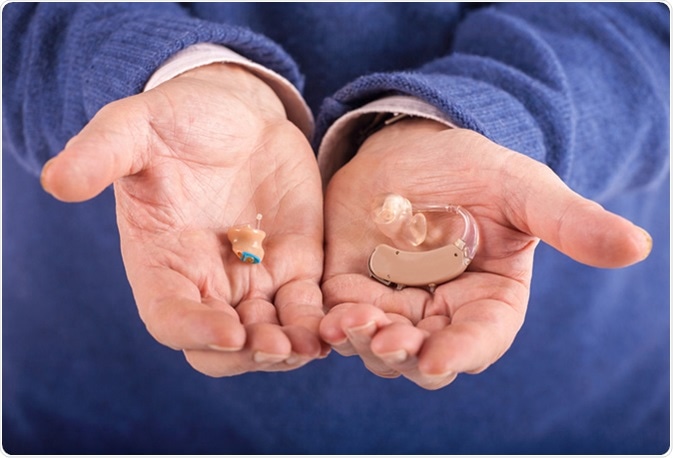As people grow older, their ability to hear gradually decreases. This biological process leads to a sensorineural hearing disorder known as Age-Related Hearing Loss (ARHL) or Presbycusis.
Presbycusis is the third most common chronic health condition among the elderly and it usually affects both ears equally. While men develop a high-frequency hearing loss, women mostly show a low-frequency hearing loss.

Old man's hand showing a CIC (completely in canal) and a BTE (behind the ear) hearing aid - Image Credit: andras_csontos / Shutterstock
Presbycusis - causes and effects
Tiny hair cells that line the bottom of the cochlea in our inner ear aid us in hearing. As we get older, these hair cells get damaged and gradually die, leading to presbycusis. This is a permanent disorder as the damaged hair cells do not regrow.
Additionally, some changes occur in the central auditory system due to the effects of aging. The neurons in the auditory system may reduce slowly. They also begin to age and hence accumulate an aging pigment, lipofuscin. The volume of the auditory structure becomes less compared to that of the younger, which is due to the loss of neuropil.
Although aging is the biggest factor that causes presbycusis, other factors such as high blood pressure, diabetes, medicines that are toxic to the sensory cells, smoking, long exposure to loud noise, family continuum also contribute to this condition.
Sometimes abnormalities of the outer ear or the middle ear such as the reduced function of the tympanic membrane or the three tiny bones in the middle ear can also cause ARSL.
Most of the elderly who are affected with hearing loss have a combination of both age-related hearing loss and noise-induced hearing loss.
The Health Impacts of Age-Related Hearing Loss (CC)
Signs and symptoms
As presbycusis happens very gradually, it cannot be easily recognized.
The different signs and symptoms that are associated with ARHL are as follows:
- The sound of other people's talk seems mumbled.
- People start repeating dialogues for you to hear.
- Difficulty understanding when there is a noisy background.
- Difficulty in keeping pace with group conversations.
- Feeling a need to apply more concentration while hearing.
- Your TV/music volume seems too loud for others.
- Difficulty in telephone communication.
- Difficulty in distinguishing high-pitched sounds like “s” or “th.”
- A masculine voice seems more audible than a feminine voice.
- Some sounds seem too loud and irritating.
- Tinnitus inside the ear (a ringing/roaring/hissing sound).
Types of presbycusis
Depending upon the part of the auditory system that gets damaged or the source of damage, presbycusis can be divided into four types, as follows:
- Sensory Presbycusis: When individuals suddenly lose hearing in the frequency range of 4 kHz, they are diagnosed with sensory presbycusis. The organ of Corti is flattened due to the loss of sensory and supporting cells. Typically, sensory cell degeneration happens at the basal end of the cochlea. Outer hair cells are affected first. Its damage is often associated with some amount of loss in the neural spiral ganglion cells and inner hair cell damage can lose ganglion cells. The hearing loss is progressive as the hair cell will start losing stereocilia. The neurosensorial epithelium will be modified as undifferentiated epithelium as the pillar cells are affected.
- Neural Presbycusis: The ratio of hearing loss, in this case, is proportional to the increasing sound frequency. The damage will be caused to the first-order sensory neurons; this includes lipofuscin accumulation, and spiral ganglion neuron cell body degeneration. Abnormal transmission is possible if the myelin sheath in the auditory nerve fiber is disrupted. Speech discrimination is severely reduced due to the loss of 50% or more of cochlear neurons, affecting the quality of life of the individuals. Patients may find it difficult to hear in a noisy location and this may lead them to social isolation.
- Metabolic Presbycusis: Hearing loss may begin at the age of 30 years and progresses gradually. The degeneration of the vascular stria may disturb the function of the ear, causing metabolic presbycusis. The hearing threshold is related to the reduced potential of the endocochlea. Women are prone to this type of hearing loss and genetics also add to this cause. There is a limited influence on speech audiometry. There will be a hearing loss of about 30–40 dB in this case.
- Mechanical Presbycusis: This type of presbycusis happens due to the changes in the mechanical properties of the cochlea's basilar membrane, such as thickening, especially at the basal cochlea, and showing of calcified, hyaline, or fatty deposits. Changes in the hair cells or sensory neurons do not occur here.
Mixed presbycusis and intermediate presbycusis are the other two types of ARHL. If a combination of all four main types of presbycusis happens together, it is mixed. Additionally, if the damage is microstructural in the tip links of stereocilia and mechanoelectrical transduction channels it is intermediate.
Diagnosis and treatment/rehabilitation of ARHL are the same as that of any other sensorineural hearing loss. Hearing aids and implants are widely used to help patients with ARHL.
References
Further Reading